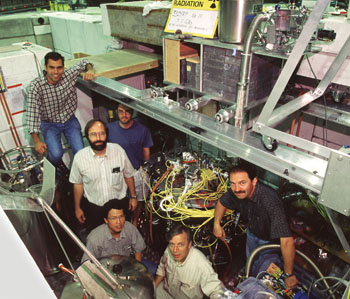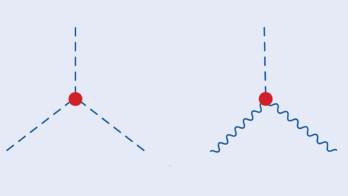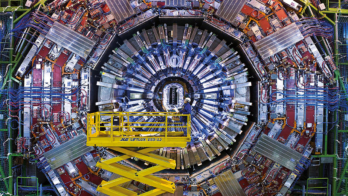Symmetries underpin much of modern physics and, as a consequence, are sensitive probes for new phenomena. Neil Russell reports from a recent meeting held at Indiana University, where physicists discussed possible symmetry-violating mechanisms that could open the way to a deeper understanding of our universe.

The Bloomington campus of Indiana University, US, hosted its second meeting on CPT and Lorentz symmetry (CPT ’01) on 13-15 August 2001.
The meeting, which was attended by physicists from the US, Japan and Europe, focused on experimental and theoretical developments in the study of space-time symmetries. The first meeting solely on this topic was held in Bloomington in 1998.
Some of the most fundamental symmetries in physics are the space-time symmetries of Lorentz transformations – where the laws of physics are unchanged under boosts and rotations – and CPT – the combination of charge conjugation (C), parity inversion (P) and time reversal (T). Interest in these symmetries has flourished in recent years as attempts to find cracks in the Standard Model have intensified.
Lorentz symmetry, which states that reference frames are equivalent if either rotated or moved at a constant velocity with respect to each other, appears to be an exact symmetry in nature. So too does CPT symmetry. The 1954 CPT theorem of Bell, Lüders and Pauli states that any Lorentz-invariant field theory must be CPT-invariant. No experiment has detected any violation of either symmetry, but as experimental tests of CPT and Lorentz symmetry continue to improve, some intriguing opportunities to resolve asymmetry arise.

CPT ’01 was opened by distinguished physicist Yoichiro Nambu of Chicago, US, who gave a historical perspective on the topic of CPT symmetry in physics.
For CPT symmetry to be broken in any theory, one of the preconditions of the CPT theorem must be removed. One possibility is to base the theory on extended objects – as in string theory, for example.
The Standard Model extension of Alan Kostelecky of Indiana University, US, uses this idea and spontaneous symmetry breaking as the context in which the Standard Model lagrangian is supplemented with general CPT- and Lorentz-violating terms. The extension has all of the usual features of the Standard Model of particle physics, except for the breaking of the two symmetries.
Since the first meeting on Lorentz and CPT symmetry in 1998, when only a handful of experimental bounds were known, a steady stream of new limits on CPT and Lorentz symmetry has been flowing. Kostelecky presented an overview of the theory – developed over a period of 10 years – and discussed the variety of experiments at the high-energy and high-precision frontiers that could be in a position to detect effects. The Standard Model extension is giving new impetus to Lorentz and CPT tests by isolating specific types of signals in an explicit framework. The ideas are intriguing, since many experiments have never probed effects with the characteristics that are predicted in this theory. One of these effects is sidereal variations in frequencies that were previously thought constant.
Sidereal variations occur because the theory challenges the traditional idea that empty space is isotropic and structureless, suggesting instead that special directions exist. In fact, most experiments point in a particular direction, given, for example, by the orientation of a linear accelerator, the plane of a cyclotron, or the magnetic field in an atomic clock. It is customary to ignore this orientation, because space is considered directionally inert.
However, if empty space has a faintly resolvable structure, including directional dependence, it may be possible to find variations in measurements repeated over time as the orientation of the experiment changes with the rotation of the Earth. Several speakers at CPT ’01 reported attempts to isolate sidereal variations of this type. Impressive bounds on Lorentz and CPT violation have resulted.
<textbreak=Non-commutativity>
An interesting theoretical development relating to the Standard Model extension is the realization that the model contains non-commutative field theory. Roman Jackiw of MIT, US, discussed Lorentz violation in non-commutative photodynamics. He also pointed out the relevance of non-commuting spatial variables in quantum mechanics. Other speakers discussed related issues, including a conservative bound on the non-commutativity parameter of (10 TeV)-2. This has implications for Lorentz violation, since a non-commutative theory is recovered from the Standard Model extension by choosing suitable values for the parameters.
Robert Antonucci of the University of California at Santa Barbara, US, discussed implications for symmetry tests using polarization data from astronomical sources, such as quasars, and Indiana University’s Matthew Mewes presented a new bound based on polarization-axis comparisons of light from such sources. The result is one of the most stringent bounds on Lorentz symmetry to date, of three parts in 1032. This complements tests performed on systems within other sectors of the Standard Model extension.

Two CERN collaborations among several efforts worldwide to test fundamental symmetries are ATHENA and ATRAP, which plan to trap cooled antihydrogen for high-precision spectroscopy. ATRAP spokesperson Gerald Gabrielse of Harvard University, US, reported that his experiment is making good progress. The idea is to compare antihydrogen spectral frequencies with the corresponding frequencies that are known to a great precision for ordinary hydrogen. CPT symmetry requires that the comparison shows no differences. Since summer 2000, when the CERN antiproton decelerator began operation, steady progress has been made by CERN groups in the development of technology to create antihydrogen in a trapped form.
Continuing the search
A number of neutral-meson high-energy experiments continue to search for violations of Lorentz and CPT symmetry. For the K, D and B mesons, Lorentz-violating effects depend on the particle momentum. It is therefore of interest to search for speed- and orientation-dependent signals. Hogan Nguyen of the KTeV collaboration at Fermilab, US, reported a new result bounding parameters for CPT violation at 10-21 GeV in the neutral-kaon system.
Rob Gardner of the FOCUS collaboration at Fermilab presented the first result of a search for sidereal variations in the oscillations of neutral D mesons. The result implies sensitivity to effects in the charm sector, bounding parameters at 10-15 GeV. Yoshihide Sakai of the BELLE collaboration at KEK, Japan, reported a recent result bounding CPT symmetry in the B-meson system.
New bounds in the lepton sector have been contributed by recent muon and muonium experiments. David Kawall of Yale University, US, reported on the muonium experiment at Los Alamos National Laboratory in New Mexico, US. Using hydrogen-like muonium “atoms” composed of a positive muon and an electron, a collaboration led by Vernon Hughes, also of Yale, studied the ground-state hyperfine transitions in this system using data taken over a two-year period.
Analysis of the high-precision data reveals no sidereal variations in any of the transition frequencies, thereby bounding the relevant parameter combinations in the Standard Model extension at 2 x 10-23 GeV. This first ever search for Lorentz violation in the muon sector provides a 10-fold improvement on the previous results. Mario Deile of Yale and David Hertzog of Illinois represented the Muon g-2 Collaboration at Brookhaven National Laboratory, US. Plans to use data from this experiment to seek out possible Lorentz and CPT violation signals in the context of the Standard Model extension were discussed. The sensitivities are expected to be competitive with those of the Los Alamos group.
Several high-precision spectroscopic measurements are also proving invaluable in testing the Standard Model extension. Nobel Laureate Hans Dehmelt’s Penning-trap group at the University of Washington, US, has placed several bounds on symmetry violation in the electron sector. These results were reviewed by Robert Bluhm of Colby College in Maine, US, who also described the theory behind other planned symmetry tests in atomic systems.
Some tests involve comparisons of particles and their antiparticles, which is possible with electrons and positrons for example, and also in muon experiments. Other tests involve monitoring atomic-clock and maser frequencies to identify Lorentz-violating variations. Ron Walsworth of the Harvard-Smithsonian Center for Astrophysics, US, discussed recent measurements and future possibilities with masers, and Mike Romalis of Princeton University, US, presented plans to build an innovative helium-potassium comagnetometer for future tests.
External influences
Resolving variations in frequencies is experimentally challenging because there are numerous environmental influences in a laboratory, such as temperature, that vary on a daily basis. Ensuring that an experiment is monitoring the right effect is critically important. New approaches towards these intricacies will be available in the near future when precision atomic clocks and masers are planned to fly on the International Space Station (ISS). It will be possible to exploit the short rotational period of about 90 min, and various other properties of the ISS platform.
Several scientists involved with ISS projects spoke at the Bloomington meeting, including Kurt Gibble of Penn State, US, who discussed the rubidium atomic-clock experiment (RACE), and Neil Ashby of Colorado, US, who presented the primary atomic reference clock in space (PARCS). Another experiment, SUMO, involves flying superconducting microwave oscillators on the ISS and was discussed by Joel Nissen of Stanford, US. It has the potential to test several aspects of fundamental symmetries. Also at the meeting was Lute Maleki, the Jet Propulsion Laboratory project manager for several ISS experiments. He outlined the novel SpaceTime experiment, which proposes to carry three oscillators on a high-speed sweep past the Sun.
One of the finest tests of CPT symmetry with electrons has been done by the Eöt-Wash group at the University of Washington, led by Eric Adelberger. The experimental apparatus, a torsion pendulum with an overall spin polarization, was described by Blayne Heckel. The results bound several CPT-violating parameters in the electron sector at about 10-29GeV.
Further information
Sidereal variations
The Standard Model extension discussed at the Indiana meeting predicts a background of minuscule directed quantities (tensors) that are fixed in space. The figures show these as red arrows filling the vacuum. Particles and antiparticles can interact differently with this background, so the combined symmetry CPT (the product of charge conjugation, parity and time reversal) can be violated. This is illustrated in Figure 1 by different properties of a basketball and an antibasketball in a laboratory on Earth. Figure 2 shows the situation 12 h later. The local direction of the arrows in the laboratory has changed because the Earth has rotated, so the CPT violation is different. Similarly, in real experiments, one way to observe CPT and Lorentz violation is to look for particle properties that vary with the Earth’s sidereal period. Results from several such experiments were reported at the meeting.
Further reading
CPT and Lorentz Symmetry: Proceedings of the Second Meeting World Scientific 2002 ISBN 9810248342.





